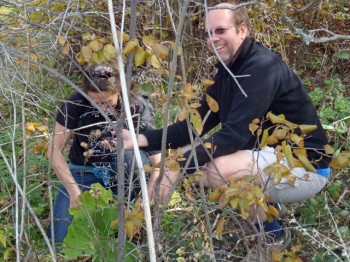
As wild food foragers, we sometimes find ourselves on unfamiliar ground. A trip somewhere new can be both exciting and intimidating. What is there to forage here?
This was the situation in which my co-foraging friend, Butterpoweredbike, and I found ourselves two weeks ago in the dry, windswept hills northwest of Lyons, Colorado. We’d been invited there by the landowner, Cheri Hoffer, after she heard of our plight to find a plot of private land on which to forage with KGNU producer Jim Pullen, who wanted to tape us foraging for radio.
Together, we drove the long, rough, dirt road there wondering whether we’d made a mistake. Neither of us was familiar with the habitat; everything seemed to be brown, and the media was on its way. What were we going to find? Crap.
Fortunately Jim was a tolerant fellow, patiently recording my long list of must-says regarding foraging regulations, my homages to all the expert foragers from whose expertise I’ve benefited, a heads up on Hunt, Gather, Cook author Hank Shaw’s dinner tonight at the Black Cat in Boulder, safety tips and the like—choking on my words and then stopping and restarting again all the while—before actually getting around to foraging.
As it turns out, not much of this stuff made the radio. Instead, limited to just a few minutes of air time, Jim was more interested in the candid, giddy and humorous exclamations of us two “raging intellects” (he called us that) exuberant over whatever wild food we could manage to find.
Before going any further I therefore feel obligated to provide a synopsis of current foraging regulations for public lands in the Boulder/Denver area:
Boulder-Area Foraging Regulations
National Forest regulations vary, so it’s good to learn them on a forest-by-forest basis by contacting the local Ranger District of the forest you hope to forage in advance of your visit.
According to the public affairs office for the Arapaho/Roosevelt National Forest and Pawnee Grasslands, which abut the major metropolitan areas of Denver and Boulder, foraging plants in quantity in these forests is simply not allowed, as the potential impact is too great. That said, foraging a handful or tasting non-threatened plants in these forests is allowed; the policy is called “incidental use” and is designed to allow for a “personal experience” with nature. Incidentally, an “incidental” quantity is probably a good place to start for new foragers anyway.
The public affairs office also indicated that well-used locations like trailheads and campgrounds in local national forest areas may have been sprayed to slow the spread of the pine beetle infestation, so those would not be areas from which to taste-test.
Some seasonal forest products—like firewood and transplants—can be collected upon obtaining a permit, which are available from forest service offices such as the Boulder Ranger District (303-541-2500).
The policy on Boulder County Open Space lands is zero-plant picking.
None of these regulations apply to foraging private land, hence our interest in finding some for the radio interview. There, only the landowner’s rules apply—those, and of course nature’s rules for sustainability such as not clear-cutting or otherwise damaging habitat, leaving enough of the individual plant or colony for it to be able to regenerate, and, as Sam Thayer explains, foraging plants “with single underground storage organs like single roots, tubers, or corms” only from rich stands, as removal of these organs kills the plants.
Foraging Gold in Nature’s Gutters
We all but struck out on the hillside with Jim Pullen that day, finding one mullein (Verbascum thapsis: The leaves make for good tea after the fine hairs are strained out, in addition to the plant’s medicinal uses) and one dandelion to fawn over.
Luckily, we had more success when Cheri led us down into a tangled gully on the backside of her hill. In that protected, damp zone we found wild oregano (Monarda fistulosa), burdock (Arctium sp.), and ripe rose hips (Rosa sp.), to name a few, despite it being mid-October already. Butter made me crawl deep into the underbrush to dig out a burdock root with her hori hori and both Jim and I emerged covered in burs from head to toe—but with some good recordings regardless.
Shameless Dog Boarding Plug
Big thanks are in order to Cheri Hoffer of Canine Campovers, a network of home boarders catering to dog owners throughout the Boulder/Denver area, for offering up both her time and land to our emergency foraging cause. Board your pup with Canine Campovers today!
On Air with Maeve Conran
To listen to the show, tune into KGNU’s Morning Magazine this morning between 8:00 and 8:30 Mountain Time or stay tuned for a download link—and try not to laugh when I stutter, okay?

Always an adventure, isn’t it?